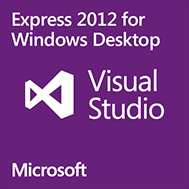| Visual Studio Express 2012 |
| Written by Mike James | |||
| Thursday, 13 September 2012 | |||
|
With the launch of the full Visual Studio we also have a collection of other announcements. VS Express 2012 can now be used to develop desktop apps for Windows 8, but the story isn't quite as simple as it seems. First the good news - you can use VS Express 2012 to develop desktop apps - but not the same one you use to develop WinRT apps. Initially Microsoft was trying to tell programmers that Express 2012 would only create WinRT apps and if you they needed to create a desktop app for Windows 8 then you should use an older version of Express. This caused some grumbling, rightly so. After all, Microsoft's actions simply fit in with the idea that it is trying to stamp out the desktop app in favor of the new modern app. While you can understand why Microsoft wants to push forward, and many programmers want to follow it, we have a lot invested in the desktop and just because it isn't called "modern" doesn't mean it is out of date.
What Microsoft has done is to create an alternative version of VS Express 2012; there is now the Windows 8 version, which creates only WinRT apps, and the Windows Desktop version, which creates only Win32 apps. Notice that the "8" is missing from the Desktop version as it will run under Windows 7 as well as under Windows 8. There is also a Web version of VS Express 2012, which makes a total of three versions if you want all of the facilities on offer. The Web version allows you to create ASP.NET websites. This also runs under Windows 7 and 8. This isn't good, but at least it is workable and the cost of having to install two versions isn't that great. After all, VS Express 2010 was segregated into different versions for each of the main languages. At least the 2012 version offers you projects in VB, C# and C++, which is an advantage. Earlier versions of VS Express did support both types of application development so it is a puzzle as to why Microsoft decided to split them up in this way. Of course one possible reason is that if you have installed the Window 8 WinRT version you wont be tempted to start a Win32 project because these are only offered if you download the "other" VS Express. Once you have installed VS Express for Windows Desktop you can create Forms, WPF or a console application. There are currently no online templates and this means that Silverlight, XNA and a few other project types are missing from the mix. In the future you should be able to use the NuGet package manager to integrate other libraries with your projects. You can take a project created in VS Express 2012 and load it into the full Visual Studio. New features are a unit testing framework, code analysis, and Team Foundation Server integration. What exactly integration with TFS is for is a mystery, given that you are only supposed to use Express for evaluation. You can also now connect to any SQL Server data source, which extends how far you can get with just the Express version. Given that VS Express 2012 for Windows Desktop runs under Windows 7 and 8 you now have a choice - stay with one of the 2010 Express versions or move to the latest. In terms of support for a wider range of projects, 2010 has the edge. However, there is always the issue of using the latest rather than the previous version and I can see that many will upgrade even if they don't need any of the extras. One factor in the choice might well be the user interface - it is very strange seeing the Windows 8 flat gray look on a colorful Windows 7 desktop.
More InformationRelated ArticlesVisual Studio 11 Express Is Metro Only Visual Studio 11 Goes Color - Slightly VS 11 Grey Goop - Few Happy Without Color Three Windows 8 Editions Clarify the WinRT Position How Microsoft Could Have Done Metro
Comments
or email your comment to: comments@i-programmer.info
To be informed about new articles on I Programmer, install the I Programmer Toolbar, subscribe to the RSS feed, follow us on, Twitter, Facebook, Google+ or Linkedin, or sign up for our weekly newsletter.
|
|||
| Last Updated ( Thursday, 13 September 2012 ) |


